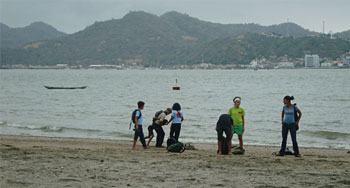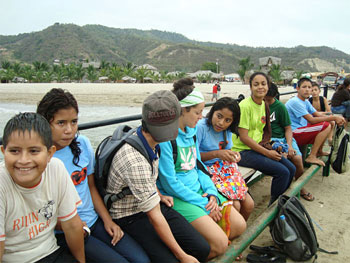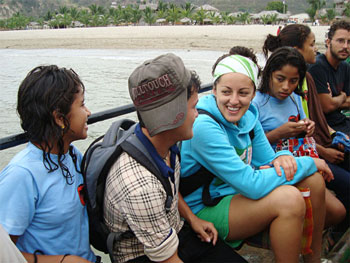Paola’s Report #2
Bioregionalism Education
Summer Session, 2009
June 11 & 12, 2009 – English
(Click here for Spanish/Español)
Photos below
This week, instead of 18 kids, I had class with only ten, which felt significantly mellower. Although I knew it was relieving, without the usual boisterous bubble that we interact in, I felt a bit of an emptiness, surprisingly. The kids explained to me that their school had recently given out grades, so if there were kids missing it was because their parents didn’t let them come for one of two reasons: so that they could focus more on their homework, or maybe just out of punishment. Whenever a kid misses class, the message gets passed on to me from another kid; it’s always comforting to know that they go through the trouble to let me know.
So today, we discussed the ocean’s magnitude, both in terms of size and richness of species. The reading stated that the ocean covers 70% of the planet, a fact that I didn’t know but all of the kids did. “That’s why we’ll never run out of water,” commented one student. And before I could say anything, the rest of the class was already scolding him about why that was not true, which was a relief.

We talked about some of the species that we can see on the beaches and in the water, like seabirds, crabs and shrimp. I asked if anyone had ever seen dolphins before; almost everyone raised their hands excitedly and told a story about when they had seen them pass in the distance from the shore. Whales, almost nobody had seen before. Whale-watching tours tend to be costly and are more for tourists. “Has anyone seen sharks?” I asked. Bryan, the one kid who seems to know the most about rural living, told us that he sees them all the time when they get caught in fishermen’s nets, explaining that sometimes they get accidentally killed. Fishing regulations were also mentioned in the reading. Bryan was able to tell us about the local regulations and the fact that a lot of fishermen don’t follow them.
We then learned about the Humboldt Current, a topic the kids had never heard mentioned before. We read that in the summer a lot of marine life travels here on this cold current and that it changes its course at the Cabo Pasado beach. And even though this important navigational and geographical landmark is only 30km north of Bahía, no one in the class had ever heard of it before either.
The reading had us look at the relationship between humans and the sea. The kids recognized the sea as a source of food and the reading alerted them to the alarming level of ocean pollution. One of the comprehension questions asked how our trash could affect the animals that live in the ocean. I explained that sometimes animals mistake trash for other fish and eat it or become entangled in it and die. The kids agreed with the reading’s proposal to create local campaigns to protect ocean ecosystems. I encouraged them to think about the process of starting and maintaining such a program. Although the details were a little harder for them to conceptualize, they brainstormed ways of encouraging others to reduce their consumption of a major source of ocean pollution, plastic.
Another interesting question in the reading was how much fish we thought fishermen used to catch 30 years ago compared to now. Again, we concluded that human contamination must be one of the causes of the decline in fish populations. Looking at an example within the bioregion, the local shrimp industry alone destroyed 80% of the mangroves.

The following day, we took a field trip to the beach of San Vicente. We crossed Rio Chone estuary on the small boats that carry passengers all day. Immediately upon arriving we played soccer, volleyball, tag and more, all with the same deflated old ball.

The kids complained that the beach was dirty and had too many rocks, but I could tell that some of them were also secretly delighted to find more shells. Some of us sat and contemplated the difference in the content of the sand. We had a nice chat analyzing why we think that sand forms differently in different beaches.

We returned to Bahía in a big ferry that spends all day carrying cars and trucks back and forth from one side of the Chone River to the other. Even though there were trash cans aboard, the floor of the ferry was covered with ice cream wrappers and plastic bottles and bags. For the first time, I noticed how much of the trash the wind was blowing into the water. As I got lost in a sort of trance watching this phenomenon, something even worse happened.

As a plastic bottle was rolling from side to side below our seats, suddenly with one swift movement, a hand picked up the bottle and tossed it into the water. Sure enough it was Patricio, a student who had very recently joined our class. The rest of us involuntarily reacted with what came out as a collective sudden yell. And judging by the scared look on his face, I realized that he simply did not understand the significance of what he had just done. I took a deep breath while coming to terms with the fact that I had no one else to blame but myself. I understood then the significance in taking extra time to go over the principles of bioregionalism, including respect for the environment, with the kids who enter the class late or who don’t seem to get it right away.

-Paola
Translated by Paola Divita
Paola-June 11 & 12, 2009 – Spanish/Español
El tema de esta semana se trataba del mar y su grandeza. Los niños ya sabían muy bien que el mar ocupa el 97 % del planeta, “por eso nunca se nos acabara el agua” dijo un niño; antes que yo pudiera decir algo, los otros niños ya le estaban comentando por qué las cosas no son así. Conversamos un poco sobre lo que podemos observar en el mar desde aquí en Bahía, como las aves marinas, los peces, camarones y cangrejos. “Quién ha visto delfines?” les pregunté. Casi todos alzaron la mano y emocionados contaron donde y cuando. “Ballenas?” Solo dos niños habían paseado con sus familias a verlas pasar. “Y tiburones?” “Sí. . .por televisión” bromearon todos. Un niño contó que los ve cuando salen muertos, enredados en las redes de los pescadores; un tema que luego pudimos relacionar a las vedas de la bioregión. La lectura habló sobre la corriente de Humboldt, algo que ninguno de los niños había escuchado hablar. Aprendimos que esta corriente fría trae muchos animales marinos en el verano y se desvía en Cabo Pasado, que a pesar de quedar solo a 30km al norte de Bahía, tampoco nadie conocía.
Continuamos con una conversación sobre la relación que tenemos los humanos con el mar; que nos da comida pero sin embargo nosotros somos los que mas lo contaminan. Los niños preguntaron cómo es que nuestra basura puede afectar a los animales que viven en el mar. Les expliqué que a veces se comen basura pensando que es alimento o se enredan y se mueren. Los niños dijeron que se debe hacer campañas para proteger los ecosistemas marinos; pregunté como se pudiera comenzar una y qué se puede hacer, pero los detalles se nos hicieron un poco difícil de formular.
La lectura nos preguntó qué pensábamos que diría un viejo pescador sobre cuántos peces atrapaba antes, comparado a cuantos atrapa un joven pescador hoy en día. Los niños enseguida contestaron que antes se atrapaban más; racionalizaron que era por que los viejos pescadores tenían más experiencia. Me admiró la respuesta ya que a mi no se me había ocurrido eso; expliqué que también podría ser porque antes había más peces que ahora. Los niños opinaron que podría ser por la contaminación y el descuido, sobre todo de la industria camaronera de la bioregión.
El próximo día cruzamos el estuario en botes pequeños para llegar a la playa de San Vicente. Al llegar los niños comentaron sobre todas las diferencias entre esta playa y las de Bahía; se quejaron que estaba muy sucia y tenía muchas piedras, pero lo que sí tenía de lindo era que se podían encontrar más conchas. Con algunos niños contemplamos un poquito el proceso de la formación de los distintos contenidos de las arenas en playas diferentes. Regresamos a Bahía en una barra gigante, que pasa todo el día moviendo el transporte terrestre de un lado del Río Chone al otro. A pesar de que hay basureros, el piso de la barra está lleno de basura y mientras va navegando, el viento va tirando la basura al agua. Mientras algunos nos quedamos en trance observando el fenómeno, algo aún peor ocurrió. Rodaba una botella plástica de lado a lado debajo de nuestro asiento, cuando de repente un niño que apenas iba una semana en nuestra clase, agarró la botella y con un movimiento muy ligero la soltó por fuera de la barra. Inmediatamente todos los demás pegamos un grito; asustado, el niño se volteó a ver mi reacción y comprendí que simplemente no entendía el significado de lo que había hecho. Me dí cuenta que a pesar de que algunos niños entran cuando ya vamos por mitad del programa o sólo se aparecen para los paseos, es importante darme el tiempo para explicar mejor la base de bioregionalismo y el respeto a la naturaleza.

Reader Interactions